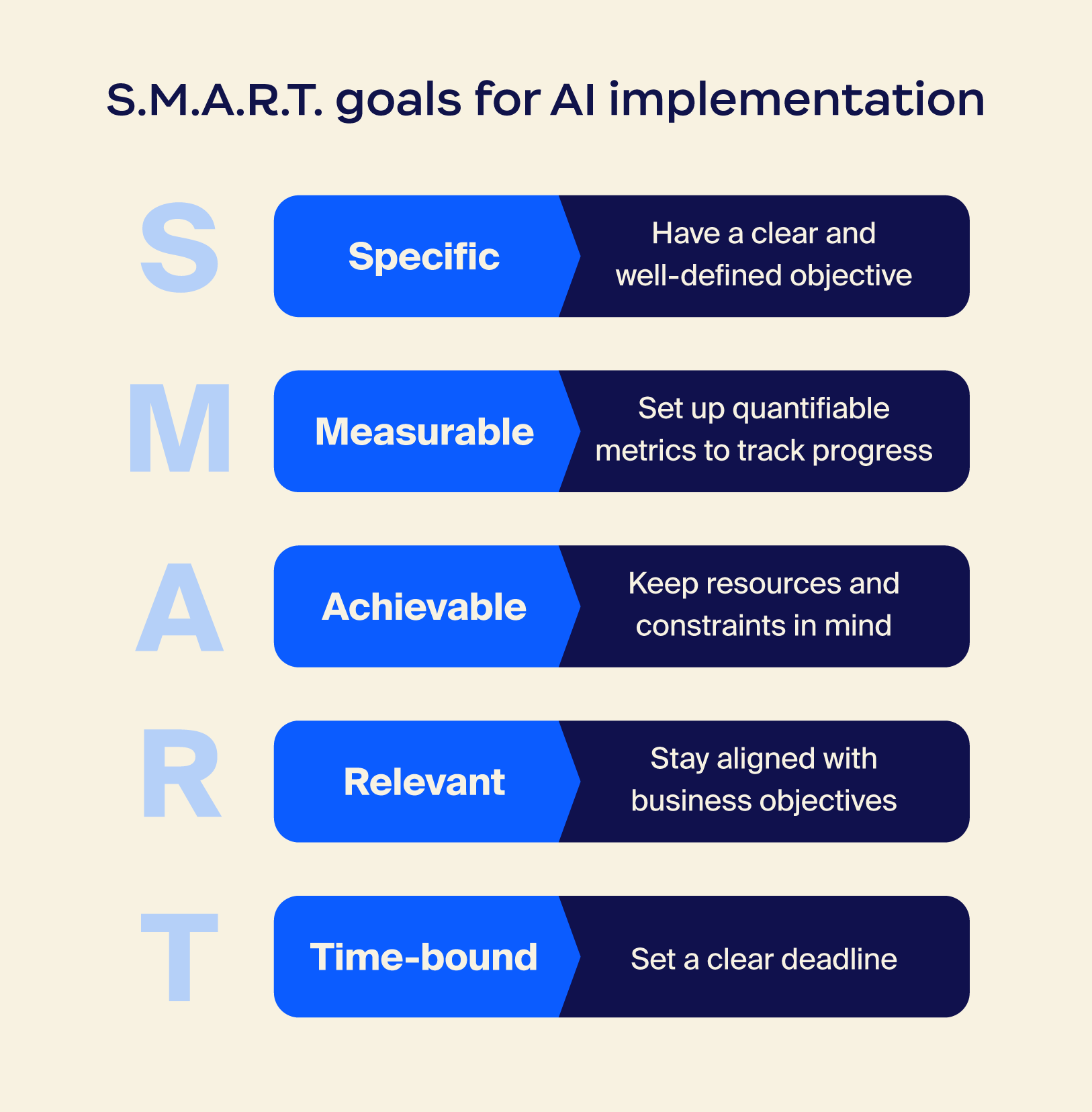
Meet Zoom AI Companion, your new AI assistant!
Boost productivity and team collaboration with Zoom AI Companion, available at no additional cost with eligible paid Zoom plans.
Updated on July 15, 2025
Published on July 15, 2025


Imagine a workday where mundane tasks vanish, strategic insights appear in seconds, and collaboration flows seamlessly across time zones. According to a recent McKinsey study, 92% of companies plan to increase their AI investments within the next three years, signaling a rapid integration of intelligent systems into our daily workflows. This isn’t a futuristic fantasy; it’s the reality of AI in the workplace today.
From automating workflows to enhancing decision-making, artificial intelligence is reshaping how we work, communicate, and collaborate. This article will dive into the transformative potential of AI, exploring its top benefits, implementation challenges, and how it’s being used to empower employees and unlock new levels of productivity.
The landscape of artificial intelligence in the workplace is constantly evolving, driven by rapid technological advancements and changing business needs. Staying ahead of these trends is essential for organizations seeking to leverage AI and maintain a competitive edge.
From the rise of generative AI to the increasing focus on ethical AI implementation, powerful forces are shaping the future of work. Here are some key trends transforming how we work and collaborate.

Even in its relative infancy, artificial intelligence is already leaving an undeniable mark on the modern workplace. From automating tedious tasks to providing insightful data analysis, here are just a few of the ways businesses are using AI to optimize their workflows:
To support recruitment and onboarding, AI can write job descriptions, even when you’re not familiar with the nuances of the role or the latest skills required. The system can even create personalized onboarding experiences that set new hires up for success from day one.
AI also helps create more engaging and supportive workplaces by leveraging natural language processing to craft survey topics and questions and publish surveys to better understand workload patterns and provide insights into potential burnout. This allows you to address employee well-being proactively. For example, AI can help process and derive insights from employee feedback to detect patterns of employees consistently working late hours and suggest interventions like adjusted deadlines or additional resources.
It’s predicted that half of today’s work could be fully automated by 2045, so there’s no better time to introduce AI into your day-to-day work life. New tools like AI assistants effortlessly handle tedious tasks like data entry, scheduling, and report generation, freeing up your team for work that actually matters.
AI-first platforms can also assist in project management task assignment, deadline tracking, and optimizing workflows so projects stay on track and teams collaborate seamlessly. And when things aren’t running smoothly, AI can predict potential risks and delays, allowing you to proactively address issues before they escalate.
Delight customers with lightning-fast responses from AI-first chatbots, virtual assistants, and automated ticketing systems, turning support into a seamless experience. This 24/7 availability lets customers receive assistance whenever they need it, leading to higher customer satisfaction and loyalty.
AI can also create and maintain an internal knowledge base that employees can easily search. It can analyze employee questions and identify gaps in the knowledge base, suggesting new content to be created. This helps employees have access to the information they need when they need it.
Unearth hidden trends, predict future outcomes, and generate insightful reports with AI’s analytics and reporting, giving you the edge in decision-making.
You can also make data-driven decisions with AI’s insightful recommendations and scenario analysis so you can navigate complex challenges with confidence. This empowers leaders to anticipate market shifts and optimize strategies proactively.
Check out our complete AI implementation guide.
Ready to bring the transformative power of AI into your daily operations? Adopting AI doesn’t have to be daunting. With a strategic approach and a focus on practical applications, you can seamlessly integrate AI tools and technologies into your workplace. Let’s explore the key steps to unlocking the potential of AI and driving innovation within your organization.
Before diving into AI solutions, pinpoint specific challenges or opportunities within your organization that AI can address. This involves a thorough analysis of current workflows, pain points, and areas where efficiency can be improved.
Ask yourself questions like “Where are we losing time or resources?” and “What tasks are repetitive and could be automated?” By clearly defining your needs, you can facilitate targeted, effective, and tangible results from AI implementation.
After you’ve identified your needs, it’s important to establish specific, measurable, achievable, relevant, and time-bound (SMART) goals for your AI implementation. This will provide a roadmap for your project so everyone is aligned on the desired outcomes.
For example, instead of a vague goal like “improve customer service”, aim for a SMART customer service goal like “reduce average customer support response time by 20% within six months using an AI-first chatbot.” Clear goals provide a benchmark for success and allow you to track progress effectively.

AI thrives on data, and the quality of your data directly impacts the performance of your AI solutions. Before implementing any AI system, conduct a thorough assessment of your existing data infrastructure. This includes evaluating the volume, accuracy, and accessibility of your data.
Determine if your data is clean, consistent, and structured in a way that AI algorithms can effectively process. If your data is lacking, you’ll need to invest in data cleansing, integration, and management strategies to lay a solid foundation for successful AI deployment.
With a clear understanding of your needs, goals, and data, you can now explore all the different AI tools and platforms available. Seek solutions that directly address your identified needs and seamlessly integrate with your existing systems. Consider factors like scalability, ease of use, security, and vendor support.
Before rolling out AI solutions across your entire organization, initiate a pilot program or proof of concept in a controlled environment. This allows you to test the tool’s performance, identify potential issues, and gather valuable feedback from users. Starting small minimizes risk and provides an opportunity to fine-tune the system before a wider launch.
Implementing AI isn’t just about technology; it’s about people. Provide comprehensive training to your employees so they understand how to use the new AI tools effectively and how these tools will impact their roles.
Training should cover both the technical aspects of the AI systems and the broader implications for workflow and collaboration. By equipping your team with the necessary knowledge and skills, you can foster a culture of AI adoption and facilitate an easy transition to a more intelligent workplace.
AI implementation is an ongoing process, not a one-time event. Regularly monitor key performance indicators to assess the impact of your AI systems and identify areas for improvement. Analyze data, gather user feedback, and stay informed about the latest AI advancements.
Be prepared to make adjustments, update algorithms, and refine your strategies to help your AI solutions remain effective and aligned with your evolving business needs.
After your pilot programs have proven their value and you’ve optimized your AI systems, it's time to scale up. This involves extending successful AI implementations to other departments, teams, or processes within your organization.
Develop a clear scaling strategy that outlines the steps, resources, and timelines required for expansion. Confirm that your infrastructure can support the increased demand and that your employees are prepared for the wider adoption of AI. By strategically scaling up, you can unlock the full potential of AI and drive transformative change throughout your workplace.
From streamlining workflows to unlocking new levels of creativity, AI is transforming how we work. Let’s explore the key benefits organizations are experiencing with AI integration.
AI significantly boosts workplace productivity and efficiency by automating repetitive, time-consuming tasks. From data entry and report generation to scheduling and customer service inquiries, AI can handle these mundane processes with speed and accuracy.
This automation frees employees to focus on higher-level, strategic initiatives that require human creativity and critical thinking so they can accomplish more in less time.
We know human error is a factor in any workplace, and it comes with a price. In the United States alone, the estimated cost of bad data due to human error reaches approximately $3.1 trillion annually.
AI offers a solution by automating error-prone tasks like data entry and complex calculations. Its consistency and adherence to programmed rules significantly reduce the variability that leads to costly mistakes. Implementing AI can help improve data accuracy and quality while helping businesses minimize consequences of human mistakes.
AI can transform customer experience through personalized interactions and efficient support. For instance, AI-first chatbots provide instant assistance, while recommendation engines suggest relevant products, creating a tailored journey for each customer.
In addition, AI’s ability to analyze customer sentiment from various feedback channels allows businesses to proactively address concerns and refine their services, fostering stronger customer loyalty.
AI streamlines information sharing and facilitates seamless teamwork through tools like AI meeting assistants, real-time translation tools, instant document sharing, and more. These tools can help teams stay aligned and informed, regardless of location.
AI revolutionizes workplace learning by offering personalized development paths tailored to individual employee needs. AI-driven platforms can analyze skills gaps and learning preferences and recommend specific training modules and resources.
This targeted approach helps employees acquire relevant skills efficiently, fostering continuous growth and boosting overall professional development.
AI supercharges innovation by providing powerful tools for data analysis and trend identification, uncovering insights that might otherwise remain hidden. AI-driven generative design tools can automate the creation of new product concepts and solutions, freeing up human designers to focus on more creative refinement.
AI’s ability to simulate and model complex scenarios can also aid in rapid prototyping and testing, accelerating the innovation cycle and enabling businesses to bring groundbreaking ideas to market faster.
| Benefits | Challenges |
|
- Increased productivity and efficiency |
- Workforce transition and professional adoption |
|
- Reduced human error |
- Evolution of workplace autonomy and decision-making processes |
|
- Tailored customer service |
- Data protection and confidentiality considerations |
|
- Enhanced communication and collaboration |
- Information quality assurance |
|
- Personalized learning and development |
- AI literacy and skill development opportunities |
While AI has great potential in the workplace, its adoption comes with challenges. Many organizations struggle with issues that can slow integration, like protecting data privacy and addressing employee concerns about job loss. Here are some key challenges businesses face when implementing AI solutions.
| Pro tip: To combat job insecurity, encourage a culture of continuous learning and “AI fluency.” Instead of fearing AI as a replacement, emphasize how it can augment skills. Offer workshops and resources that teach employees how to collaborate with AI tools, transforming them into “AI-enhanced professionals.” This shift in perspective, from fearing replacement to embracing augmentation, can help reduce anxiety and foster a sense of control. |
| Pro tip: Implement “Human-in-the-Loop” systems with clear feedback mechanisms. Design AI workflows that prioritize employee oversight and input at critical decision points. Empower employees to audit AI suggestions and provide feedback on algorithmic outcomes. This active participation not only improves accuracy but also reinforces a sense of ownership and agency, mitigating the feeling of being replaced by a machine. |
| Pro tip: Implement a “data transparency dashboard” accessible to all employees. This dashboard should clearly outline what data is being collected, how it's being used by AI systems, and the security measures in place to protect it. Regular audits and transparent data usage reporting can build trust and demonstrate a commitment to privacy. |
| Pro tip: Institute an “AI Data Review Team” within your organization. This cross-functional team, composed of employees with diverse expertise, would be responsible for regularly reviewing and validating the data used by AI systems. You should also have a system where employees can easily report potential data inaccuracies and contribute to data cleansing efforts. By actively engaging employees in the data validation process, you not only improve data quality but also foster a sense of shared responsibility for AI accuracy. |
| Pro tip: In the case of AI, younger employees may have more technical know-how. Consider pairing employees who have existing AI skills or are eager to learn with senior leaders or colleagues who may be less familiar with AI. This reverse mentorship program creates a two-way learning environment where junior employees can share their AI knowledge and insights while senior employees gain practical understanding and confidence in using AI tools. |
As organizations navigate the evolving AI landscape, prioritizing ethical AI development, continuous learning, and human-centered design is crucial for unlocking AI’s full potential in the workplace.
Zoom AI Companion is designed to enhance productivity and streamline collaboration — to augment human capabilities, not replace them. Instead, it empowers teams by automating routine tasks, summarizing meetings, and assisting with content creation, all within Zoom Workplace.
By consolidating disparate apps and reducing silos, AI Companion helps organizations work smarter, not harder, so teams can focus on what matters most.
As organizations increasingly adopt artificial intelligence technologies, questions are bound to arise about how these tools will impact the future of work. Below are answers to common questions about AI implementation, benefits, challenges, and best practices in the workplace.
AI is transforming workplaces by automating routine tasks, enhancing decision-making, and personalizing experiences. For example:
According to a recent study, only 12% of U.S. employees use AI daily. However, nearly two-thirds of global knowledge workers reported using it in 2024, showing that adoption rates likely vary by industry.
Companies can promote ethical AI implementation by building a framework that prioritizes transparency, fairness, and accountability. This includes implementing robust data privacy measures and providing responsible AI development and deployment guidelines.
Companies should also cultivate a culture of ethical awareness through employee training and open dialogue, ensuring all stakeholders understand AI's potential impacts and are committed to responsible innovation. Establishing an ethics review board or committee can provide valuable oversight and guidance, helping AI systems align with the organization's values and legal requirements.
While AI automates certain tasks, its primary role is to augment human capabilities, not replace them. By focusing on higher-level, strategic work, employees can leverage AI to enhance their productivity and value.